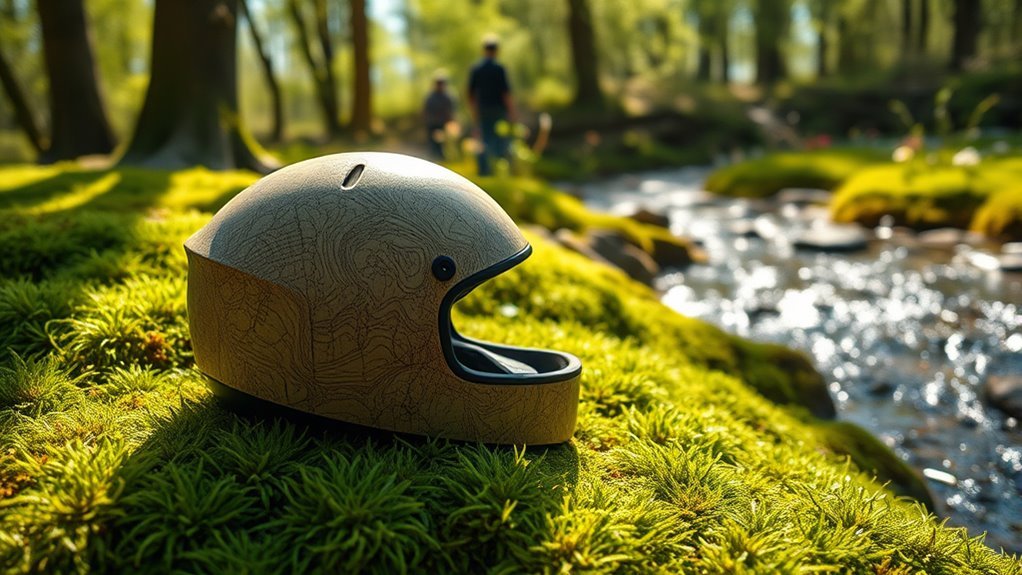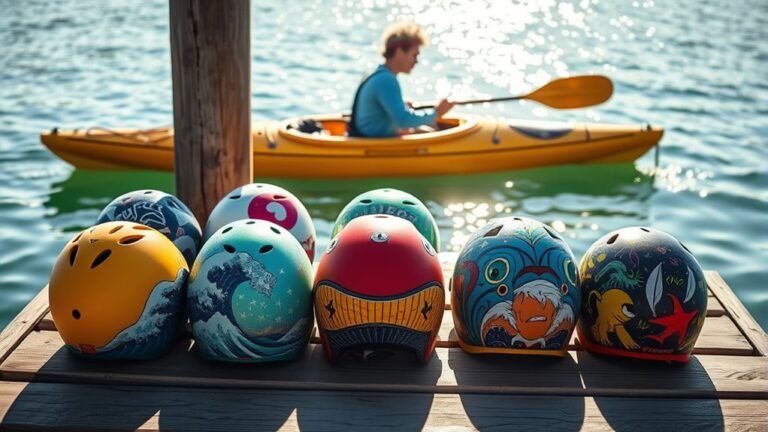Biodegradable Helmets: Myth or Reality?
Biodegradable helmets are no myth; they’re a reality gaining traction in the safety and sports gear market. Made from renewable materials, these helmets break down safely in the environment, unlike traditional helmets that can last for centuries in landfills. They meet stringent safety standards while offering an eco-friendly alternative. As consumer awareness about sustainability grows, manufacturers are innovating in this space. There’s much more to discover about how these helmets could shape the future of safety gear.
Understanding Biodegradable Materials

As you explore the world of biodegradable materials, you’ll find that these substances offer a sustainable alternative to traditional plastics, which often linger in the environment for centuries. Biodegradable polymers, derived from natural sources like corn starch or sugarcane, break down more quickly and safely when exposed to environmental conditions. Their material properties, including flexibility, tensile strength, and resistance to moisture, can be tailored for various applications, making them versatile options for consumers. Unlike conventional plastics, biodegradable materials can considerably reduce waste and pollution, aligning with your desire for freedom from environmental harm. By understanding these innovative materials, you’re empowered to make choices that contribute to a healthier planet, ensuring a better future for generations to come.
The Science Behind Biodegradable Helmets

While traditional helmets are often made from petroleum-based materials that contribute to environmental pollution, biodegradable helmets represent a groundbreaking shift in safety gear design. These innovative helmets utilize biodegradable polymers, which break down naturally over time, reducing waste in landfills.
Biodegradable helmets offer a sustainable alternative, breaking down naturally and reducing landfill waste.
Key aspects of helmet decomposition include:
- Material Composition: Made from renewable sources, minimizing fossil fuel reliance.
- Microbial Activity: Decomposition is facilitated by microorganisms, enhancing environmental compatibility.
- Timeframe: Designed to decompose within a few years, unlike conventional helmets that last decades.
- Safety Standards: Engineered to meet safety requirements while being eco-friendly.
Environmental Impact of Traditional Helmets

Traditional helmets, primarily crafted from petroleum-based materials, pose significant environmental challenges that contrast sharply with the advancements offered by biodegradable alternatives. When you consider helmet disposal, it’s crucial to recognize the long-lasting impact these materials have on our planet.
| Environmental Issue | Impact of Traditional Helmets |
|---|---|
| Decomposition Time | Hundreds of years |
| Resource Extraction | High fossil fuel consumption |
| Pollution | Toxic emissions during production |
| Landfill Contribution | Millions of helmets annually |
As these helmets degrade, they contribute to environmental degradation, leaching harmful substances into the soil and water. By understanding the impact of our choices, you can advocate for more sustainable options and promote a healthier planet for everyone.
Safety Standards and Regulations
When choosing a helmet, understanding safety standards and regulations is essential for guaranteeing adequate protection. Helmets must meet specific criteria to achieve safety certifications, which vary by region. You want to make certain your helmet complies with these regulations for your safety and peace of mind.
Understanding safety standards is crucial when selecting a helmet to ensure proper protection and compliance with regulations.
- Look for certifications from recognized organizations like CPSC or Snell.
- Understand the differences between certifications for various activities (cycling, skateboarding, etc.).
- Check for regulatory compliance to guarantee the helmet has passed rigorous testing.
- Be aware of the lifespan of a helmet, as materials can degrade over time.
Performance and Durability Concerns
As you consider biodegradable helmets, it’s essential to weigh performance and durability alongside the environmental benefits they offer. While these helmets aim to reduce waste, they may present performance trade-offs. Traditional materials have been time-tested for impact resistance and longevity, but biodegradable options can struggle to match these standards. Durability challenges arise from using organic materials that may degrade faster than synthetic counterparts, especially under extreme conditions. This doesn’t mean they’re unsafe, but it does highlight the need for careful evaluation of their real-world performance. As you explore your options, think about how these trade-offs align with your lifestyle and safety priorities, ensuring that you don’t compromise on protection while supporting eco-friendly innovations.
Consumer Perspectives and Market Trends
While performance and durability are key factors for many helmet users, consumer attitudes towards biodegradable helmets are rapidly evolving. You might be surprised to learn that growing awareness of environmental issues is shifting consumer behavior, leading to increased market demand for sustainable products.
Consider these trends:
Consider these trends shaping the future of helmet choices: eco-consciousness, brand loyalty, willingness to pay, and a thirst for education on sustainability.
- Eco-consciousness: More consumers prioritize eco-friendly materials in their purchasing decisions.
- Brand loyalty: Companies promoting sustainability often cultivate stronger customer loyalty.
- Willingness to pay: Many users are open to spending more on biodegradable options, valuing sustainability over cost.
- Education: Consumers are increasingly seeking information on product lifecycle impacts.
This shift reflects a broader movement towards sustainability, as people want to make choices that align with their values, paving the way for biodegradable helmets in the market.
Innovations in Sustainable Helmet Design
Innovations in sustainable helmet design are reshaping the way you think about safety gear. Today’s helmets are crafted from sustainable materials like bio-based plastics and recycled composites, offering not just protection but also a commitment to the environment. Eco-friendly designs are becoming the norm, featuring modular components that can be easily replaced or upgraded, reducing waste. Manufacturers are also focusing on lightweight structures that maintain strength while minimizing resources used in production. These advancements not only serve your safety needs but also align with a growing desire for freedom from harmful environmental impacts. As you consider your next helmet purchase, remember that choosing sustainable options helps pave the way for a more conscious, eco-friendly lifestyle.
The Future of Biodegradable Helmets in Sports
With the increasing awareness of environmental issues, the future of biodegradable helmets in sports looks promising. As manufacturers invest in future innovations, athlete acceptance will be vital for success. Here’s why biodegradable helmets could become mainstream:
- Sustainability: They reduce waste and environmental impact.
- Performance: Advanced materials can provide similar protection and comfort as traditional helmets.
- Regulatory Support: Growing regulations may encourage eco-friendly practices in sports gear.
- Market Demand: Athletes and consumers are increasingly seeking sustainable options.
As these factors come together, biodegradable helmets could reshape the landscape of sports equipment, promoting not just safety but also a commitment to the planet. Embracing these changes, you can be part of a movement towards a more sustainable future.
Frequently Asked Questions
How Long Does It Take for Biodegradable Helmets to Decompose?
Biodegradable helmets can take anywhere from a few months to several years to decompose, depending on the materials used and environmental conditions. Factors like temperature, moisture, and microbial activity greatly influence decomposition rates. You’ll want to reflect on the environmental impact, as quicker decomposition means less waste in landfills. Embracing biodegradable options helps promote sustainability while still providing protection, allowing you to enjoy your rides with a clearer conscience.
Are Biodegradable Helmets More Expensive Than Traditional Helmets?
Yes, biodegradable helmets can be more expensive than traditional ones. For instance, a company might charge $150 for a biodegradable helmet due to the cost of sustainable materials and production processes. This cost comparison often reflects the market demand for eco-friendly products. As more consumers prioritize sustainability, prices may stabilize, but currently, you might pay a premium for the environmental benefits these helmets offer compared to conventional options.
Can Biodegradable Helmets Be Recycled After Use?
Yes, biodegradable helmets can often be recycled, depending on the materials used. If they’re made from specific biodegradable substances, they might go through specialized recycling processes. This can greatly reduce their environmental impact compared to traditional helmets. However, it’s essential to check local recycling guidelines to guarantee proper disposal. By recycling, you help promote a circular economy, making a positive contribution to sustainability while enjoying your freedom on the road.
What Materials Are Commonly Used in Biodegradable Helmets?
Did you know that around 8 million tons of plastic end up in the ocean each year? When it comes to biodegradable helmets, natural fibers like hemp and flax are often used alongside plant-based polymers such as polylactic acid (PLA). These materials not only provide safety but also break down more easily in the environment compared to traditional plastics. By choosing biodegradable options, you’re contributing to a more sustainable future while enjoying your freedom outdoors.
Do Biodegradable Helmets Offer the Same Protection as Conventional Helmets?
Biodegradable helmets can offer similar protection to conventional helmets, but it’s essential to guarantee they meet safety standards. These helmets must demonstrate adequate impact resistance to protect you during a fall or collision. While many biodegradable options are designed with safety in mind, not all may pass rigorous testing. If you’re considering one, check for certifications to confirm they provide the same level of protection you expect from traditional helmets. Your safety shouldn’t be compromised!






